8 Day itinerary in Oman, Middle East
Oman Desert to Coast
08 Days exotic journey of Oman to catch glimpse of most highlighted places of this Monarchy. Guided tour throughout from arrival till departure. visit Sultan Qaboos Mosque, Bait Al Zubair Museum, visit Portuguese Fort, Bait Al Jubair Museum, Grand Mosque or Sultan Qaboos Mosque, Bimah Sinkhole, Coa... Read More

By Raviprasad
Overview
Physical Difficulty
Easy
Recommended Age
Everyone
Operated in
English, Spanish, French, German, Italian
GUIDANCE
Tour Leader
starting point
Muscat
trip type
Private
trip attributes
Indigenous culture
Hiking
Culture & History
Meet local people
Visit markets
Water & Coastline
Nature & Wildlife

Night

Highlights
visit of Nizwa cattle market and souk with traditional Omani Halwa tasting
Bimah Sinkhole, Coastal town Sur, Fins Beach
Turtle reserve center in Ras Al Jinz, Wadi Bani Khalid
Wahiba sands dune bashing & Overnight in Desert
visit of Nizwa cattle market and souk with traditional Omani Halwa tasting
Bimah Sinkhole, Coastal town Sur, Fins Beach
Turtle reserve center in Ras Al Jinz, Wadi Bani Khalid
Wahiba sands dune bashing & Overnight in Desert
Itinerary
standard Hotel
Accommodation Categories
Day 1
Arrival Muscat
Arrive in Muscat and transfer to your hotel. Depending on your time of arrival, there may be time to explore the city. There will be a welcome meeting by our local representative at 1700hrs at the hotel lobby where you will be briefed on the itinerary. It is also a chance to meet your fellow travellers in the group. Muscat: Strategically situated at the entrance to the Persian Gulf, Muscat has been an important trading town on the crossroads between east and west for at least two millennia. During the 16th and 17th centuries it changed hands between Portuguese and Turkish invaders several time before returning to local control. The discovery of oil in the 1960s saw Muscat grow from a small harbour town into a large and modern city, fuelling a vibrant economy and a multi-ethnic society as workers from countries such as India arrive in search of work. Muscat originally consisted only of the area known as Old Muscat, a walled town on a natural harbour which houses excellent examples of traditional Omani architecture and a couple of Portuguese built forts dating back to the 16th century.
Guide: Included for the day
Accommodation:
- standard Hotel: Al Falaj Hotel
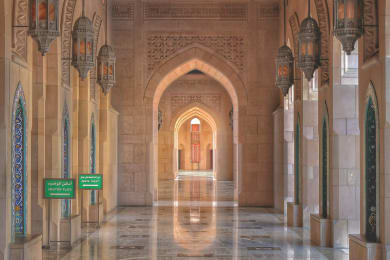
Day 2
Muscat - Sur - Ras Al Jinz
Drive through spectacular scenery of rugged mountains. Visit Bimmah Sink Hole Park & continue to Wadi Shab, a gorgeous oasis with inviting pools where it may be possible to take a dip. After lunch, continue to Sur, renowned in the past for its dhow shipyards, before reaching Ras al Jinz on the coast. After an early dinner, visit the turtle sanctuary at Ras Al Jinz, where at night green turtles, after a journey of thousands of kilometres will come ashore to lay their eggs. Sur: The attractive coastal town of Sur has long been known for its tradition of dhow building, its shipyard continuing to produce these mighty vessels which have formed such an important part of Omani culture and trade over the years, although these days there is less demand. Today it’s a relatively quiet town where one can walk through traditional markets surrounded by Omanis in their typical national dress, and it’s a good place to get a feel for local culture. Sur played a role in the slave trade for many years, being a conduit for slaves brought from East Africa on their way to the markets of Arabia, and it took many years for this practice to be eradicated in Sur after it was officially outlawed. Overnight at Hotel
Guide: Included for the day
Meals: Breakfast, Lunch, Dinner
Accommodation:
- standard Hotel: Turtle Beach Resort

Day 3
Ras Al Jinz - Wadi Bani Khalid - Wahiba Sands
Drive to Wadi Bani Khalid – an oasis spot in the middle of barren and dry mountains. It is one of the most beautiful wadis in Oman and its pools with clear deep blue water give you an opportunity to take a refreshing dip. After lunch, we head into the Wahiba Sands, a vast mass of undulating red and white sea of sand. The ever-changing patterns of the dunes are a photographer’s delight. After some exciting sand dune driving we reach our desert camp for the night. Wahiba Sands: The Wahiba Sands are characterised by enormous rolling dunes, some as high as 150 metres, stretching as far as the eye can see – a quintessential desert landscape that is as beautiful as it is austere. Named after the Wahiba tribe, the region is home to Bedouin who manage to eke out an existence around the few oases, and is also home to a surprising amount of wildlife. Immortalised by the travels of Wilfred Thesiger, a journey into the sands offers a superb opportunity to experience desert wilderness. The Bedouin: Bedouin is a collective name given to a variety of desert dwelling tribes, spread out from the Arabian Peninsula to north Africa. Traditionally the Bedouin were largely nomadic, taking their large goat hair tents and moving to find pasture for their flocks throughout the arid desert wastes. Although different tribes were united, typically the Bedu would live separately in their family groups – a necessity so as not to put excess pressure on the meagre resources of the landscape. Nowadays modernity has taken its toll on traditional Bedouin life, as many have settled in towns and cities in search of a more secure existence, but many nomadic families still exist. The recent imposition of national borders on the homelands of the Bedouin has also acted to circumscribe traditional patterns of migration. The Bedouin are famed for their culture of hospitality which dictates that they treat visitors as honoured guests. Overnight at Hotel
Guide: Included for the day
Meals: Breakfast, Lunch, Dinner
Accommodation:
- standard Hotel: Arabian Oryx Camp
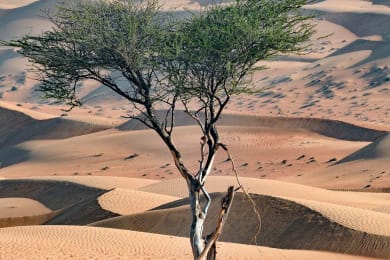
Day 4
Wahiba Desert
Full day at leisure. Enjoy lunch at a Bedouin House (Desert Tribes). A range of activities are available camp including desert trekking, camel safari, quad biking, dune bashing, etc (optional).
Guide: Included for the day
Meals: Breakfast, Lunch, Dinner
Accommodation:
- standard Hotel: Arabian Oryx Camp
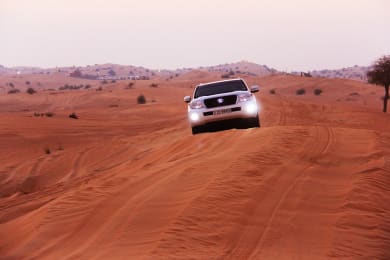
Day 5
Wahiba - Ibra - Jabal Akhdar - Nizwa
Morning drive to the historic town of Nizwa, Oman’s cultural capital Before reaching Nizwa we visit Ibra Old Houses. Continue to Jebel Akhdar via Birkat Al Mouz. We then drive to Jebel Akhdar. In Arabic Jebel Akhdar means green mountains and the area is famous for its gardens, farms and terrace plantations. We visit Wadi Habib to see one of the remote villages and fruit plantations, and also visit one of the private terrace rose plantations (only possible during April). Jebel Akhdar: Jebel Akhdar is part of the Hajar Mountains, which stretch for about 300km from north west to south east. The higher parts of the region receive enough rainfall to allow agriculture and many traditional fruits and vegetables are grown on the slopes. This is one of the most scenic areas in Oman, and is mostly inhabited by members of the Bani Riyam tribe. Jebel Akhdar was the scene of some fierce fighting between rebels and Omani and British forces in the late 1950s. Nizwa: The town of Nizwa has historically been a very important oasis offering respite from the often harsh landscape surrounding it, and is a key centre for growing dates. However it is far better known for its splendid fort, built in the 17th century and painstakingly restored in 1990. The fort is vast and contains many different sections, including a Koranic school, a mosque, a prison and living quarters. Once the capital of Oman, Nizwa became an important centre for trade and education, profiting from its strategic position between Muscat and Dhofar.
Guide: Included for the day
Meals: Breakfast, Lunch, Dinner
Accommodation:
- standard Hotel: Falaj Daris Hotel
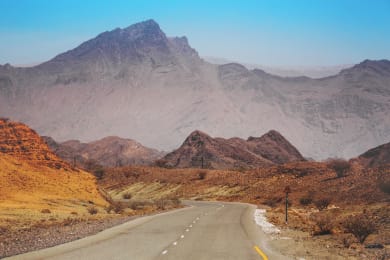
Day 6
Nizwa - Jabrin - Bahla - Jabal Shams
This morning we visit Nizwa souq as well as its famous fort, built in the 17th century. Then proceed to Jabrin castle, built in the 17th century and one of the finest of its kind. Its magnificent plasterwork, the carved doors and the painted wooden beams of the ceilings make this castle very different from others in Oman. Afterwards continue to Bahla, one of the oldest small towns of Oman and in the 12th century the local tribal capital. We make a photo stop to capture the city & its magnificent fort. After visits, continue to Jebel Shams.
Guide: Included for the day
Meals: Breakfast, Lunch, Dinner
Accommodation:
- standard Hotel: Jabal Al Akhdar Hotel
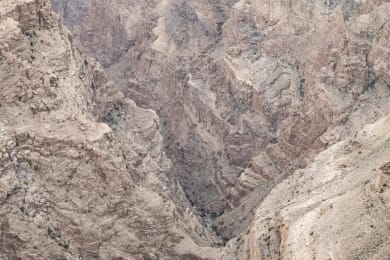
Day 7
Jabal Akhdar - Al Hamra - Wadi Bani Awf - Muscat
After breakfast, enjoy the spectacular view of Jebel Shams, the ‘Grand Canyon of Oman’. We then drive to Al Hamra and Misfah, to see one of the oldest villages of this region. The traditional mud houses dating back from 400 years are still occupied. After an early lunch, we head to Wadi Bani Awf, the end point of the canyon and with what is called the ‘snake gorge’ in the middle of the steep mountain cliffs. This is a stunning part of Oman with fantastic views of the surrounding scenery. We drive to the town of Nakhl with its fully restored fort on a rocky outcrop, before arriving in Muscat for the night. upon arrival check-in at Hotel and overnight at Hotel.
Guide: Included for the day
Meals: Breakfast, Lunch, Dinner
Accommodation:
- standard Hotel: Al Falaj Hotel
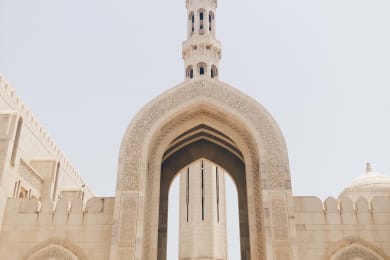
Day 8
City tour of Muscat & Afternoon Marin Dhow Cruise
Explore Muscat on a half day city tour. Visit the beautiful Sultan Qaboos Grand Mosque, one of the largest in the Middle East. Then drive through the old walled district of Muscat. Visit the famous Bait Al Zubair Museum showcasing the rich culture of Oman. We also visit Muttrah Souq, where you can bargain for handicrafts and silver items. In the afternoon we take a sunset cruise through Muscat harbour, before transferring to Muscat airport for your return flight.
Guide: Included for the day
Meals: Breakfast
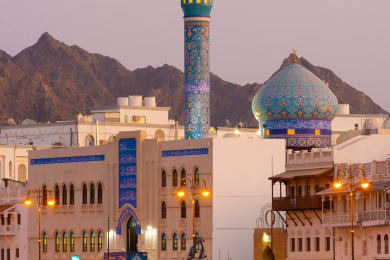
What’s Included
Accommodation
- Al Falaj Hotel
- Turtle Beach Resort
- Arabian Oryx Camp
- Falaj Daris Hotel
- Jabal Al Akhdar Hotel
Meals
- Breakfast (7)
- Lunch (6)
- Dinner (6)
Transport
- Air-conditioned vehicle with comfortable seating
Activities
- All activities mentioned as per program
Extras
- VAT / Tax / 01 (500 ml) Water Bottle per person per day
Not Included
- Visa / Insurance / Flight Ticket /Other Meal / Other service / Tips money for chauffeur and Guide
Travel that Makes a Difference
By choosing to travel with us, you support local communities, wildlife, and the environment. We are dedicated to positively impacting the world through every journey we offer.

Let’s regenerate the planet together
We overcompensate your entire journey’s carbon footprint including flights - for free.
$2,874.00 USD